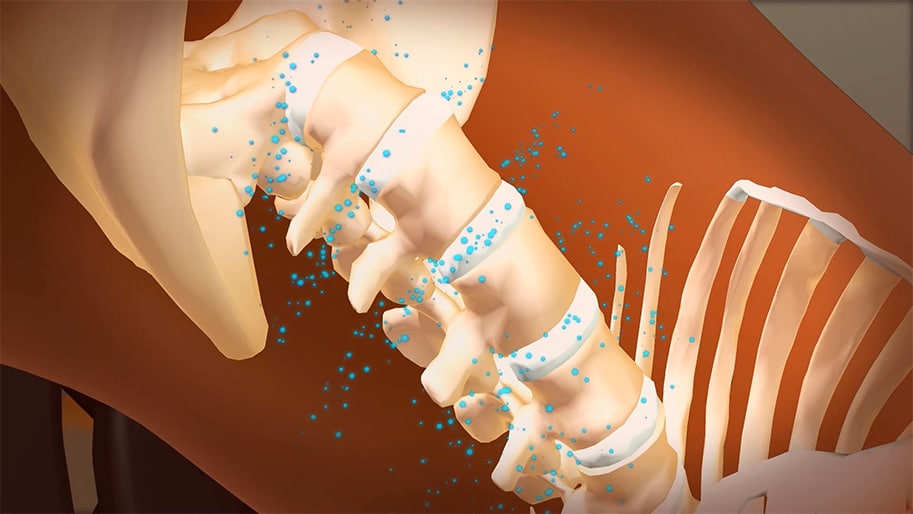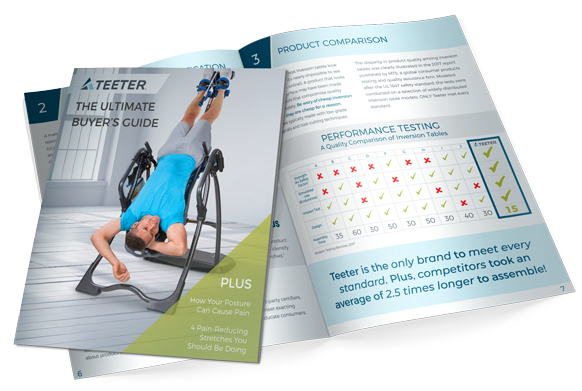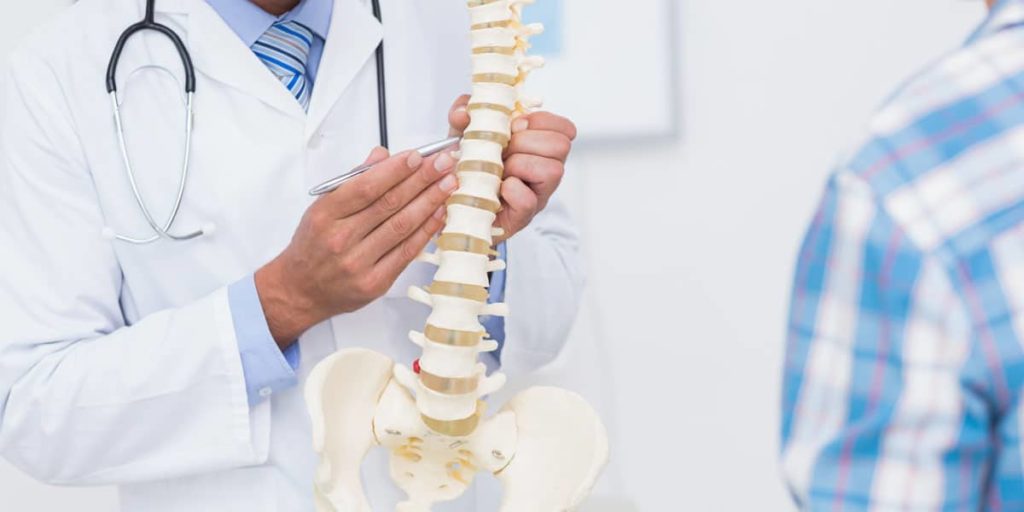Over 80% of the population will suffer from lower back pain during their lives. Though the term ‘back pain’ is often used as a blanket statement, symptoms stem from many different conditions like herniated or degenerated discs or Sciatica. Though conditions vary by individual, all back pain sufferers have one thing in common: wanting to relieve back pain.
For over three million people worldwide, that relief has come in the form of an FDA Registered 510(k) Medical Device that helps to decompress the spine and stretch supporting muscles. The Teeter Inversion Table is indicated for the following conditions:
Back Pain, Sciatica, Spinal Degenerative Joint Disease, Spinal Curvature due to Tight Muscles, Muscle Tension, Herniated Disc, Degenerative Disc Disease, Spinal Stenosis, Facet Syndrome, & Muscle Spasms
1. Back Pain
CAUSE: The causes of back pain are many, though often caused by soft tissue damage from spinal misalignments, tense muscles, or a weak core. Impact activities and daily life under the unavoidable force of gravity cause compression of the spongy discs between the vertebrae in your spine. As the discs lose moisture, the space between each joint narrows, and the chance of pinching nerve roots increases.
SOLUTION: The Teeter Inversion Table helps the body decompress, using your own body weight and gravity to elongate the back, relax tense muscles and relieve back pain. Because it decompresses using the same forces that compress the back while upright, this natural form of traction is comfortable and can be easily done in your own home.
2. Sciatica
CAUSE: The compression of the sciatic nerve causes painful symptoms, but usually has an underlying cause. Common causes of sciatic nerve pain are herniated discs, bone spurs on the spine, or degenerative disc disease in the lower back, conditions that compress the nerves that exit the spine.
SOLUTION: Less pressure means less pain. Routinely decompressing on a Teeter can open up those joints and take the pressure off the nerves to relieve sciatica and related back pain. A published preliminary pilot study performed at the Newcastle Hospital1 in the United Kingdom compared two groups of patients suffering from Sciatica that were scheduled for lower back surgery. While both groups received physical therapy for 30 days, one group also used a Teeter daily as well. At the completion of the study, those who used the Teeter showed a 70.5% reduction in the need for surgery!
Preliminary controlled study, 24 patients, various Teeter models used 3x/week for four weeks, up to six 2-minute inversions/session.
3. Spinal Degenerative Joint Disease
CAUSE: Like the discs in your spine, the cartilage in joints cushion bones to keep them from grinding together. This joint disease causes cartilage to wear away and become inflamed, leading to painful symptoms like stiffness, instability, joint lockage, and even deformity. These symptoms cause discomfort and loss of mobility that can bring your life to a halt if they go untreated.
SOLUTION: Decompression aids in joint lubrication by altering the pressure and suction forces within the joint, helping to stimulate the synovial fluid that nourishes the cartilage and enhances shock absorption. Mobilization through movement and stretching can also help improve joint health by strengthening surrounding ligaments and muscles. Strong ligaments and muscles support your joints and are vital to protecting yourself from injury.
Find Relief Now. Pay Later.
Now you can try Teeter in your own home FREE for 30-Days, 0% APR* with Affirm.
4. Muscle Tension
CAUSE: Muscle tension is typically caused by the physiological effects of stress. Muscle tension refers to the condition in which muscles of the body remain semi-contracted for an extended period, which can cause lactic acid build-up, resulting in a painful burning sensation.
SOLUTION: Teeter decompression works to gently elongate and stretch the paraspinal muscles and soft tissues of the spine, offering relaxation, reduced pain, and greater flexibility. Physiotherapist L.J. Nosse2 conducted a study focusing on the effect spinal decompression has on muscle tension and found that EMG activity declined by over 35% within 10-seconds of inversion, even at the very shallow angle of 25 degrees. Activity continued to decrease the longer the subjects remained inverted. Even after returning upright, EMG activity was found to be less than before the inversion therapy session!
5. Spinal Curvature due to Tight Muscles
CAUSE: A strong and flexible core is essential to maintaining the neutral spine position. Weak abdominal muscles cause hip flexor muscles to tighten, causing loss of proper curvature in the low back. Muscle tension or imbalance can also cause unhealthy posture or misalignments that result in back pain.
SOLUTION: Decompression helps promote better posture by stretching and elongating tight and weak muscles, helping to combat muscle imbalances and ease relieve back pain – which, as shown with the Nosse study described in the previous section, can be greatly helped with inversion. With muscles at ease and in balance, the spine will work to be in proper alignment.
6. Herniated Disc
CAUSE: As a disc degenerates, the soft inner gel in the disc can leak and create a bulge that puts pressure on surrounding nerves, causing pain to radiate throughout the body depending on which area of the spine and which nerves are impacted. This can lead to pain in the lower back, the legs, or lead to other conditions like Sciatica.
SOLUTION: Teeter helps to decompress the vertebrae, widening the space between the vertebrae and alleviating the pressure on your discs. Taking that pressure off the discs allows them to rejuvenate, filling them with nutrient-rich fluid so they naturally heal. The action of increasing the space margins between the vertebrae can create a mild suction in the disc, which may help encourage the bulged nucleus to return to its proper place or in the least, decrease the amount of pressure exerted on the nerve. Read more about how inversion therapy naturally heals a herniated disc.

Inverting widens the space between the vertebrae discs, helping the discs hydrate with nutrient-rich fluid.
7. Degenerative Disc Disease
CAUSE: As we age, the discs in our spine naturally begin to decrease in size, which causes the discs to lose their shock-absorbing capabilities and allows for vertebrae to grind together. This can eventually lead to painful bone spurs and cause inflammation that irritates surrounding nerves.
SOLUTION: Daily use of a Teeter can help combat the effects of degenerating discs by introducing nutrients and fluids back into the discs, helping to make them more resilient to pressure and reducing inflammation.
8. Spinal Stenosis
CAUSE: Spinal Stenosis occurs when a vertebra in your spine begins to narrow and compress the spinal cord, placing pressure on the nerves that travel through the spine throughout your body. Pinched nerves in your lumbar spine can cause shooting pain or cramping in your legs when you stand for long periods of time or when you walk.
SOLUTION: Regular decompression with a Teeter Inversion Table relieves the pressure on your spine and reduces inflammation of nerves and muscles with your own body weight. Reduced inflammation helps discs and surrounding tissues to heal naturally, decreasing painful pressure on the nerves. Learn more about relieving spinal stenosis without surgery.
9. Facet Syndrome
CAUSE: Facet Syndrome develops in the small joints located between each vertebra called facet joints. These joints are lined with cartilage to protect the bone from constant motion. As we age, the cartilage gradually wears away, and in many cases, bone spurs can develop. Friction between the bones leads to tenderness, swelling, stiffness, and pain in surrounding tissues.
SOLUTION: Rehabilitation of facet joints starts with movement. Inverted decompression strengthens surrounding muscles and ligaments to help the joints support the vertebrae and correct imbalances to relieve back pain. Using a Teeter also promotes greater lubrication of facet joints for greater cushion, helping to relieve the pressure that irritates surrounding tissue.
10. Muscle Spasm
CAUSE: A Muscle Spasm is your body’s response to injury or underlying anatomical problems. In the case of an anatomical problem like Degenerative Disc Disease or a Herniated Disc, the muscle instinctively reacts to the pain and inflammation by going into a spasm.
SOLUTION: Inverted decompression helps to align and gently elongate the spine, reducing pressure on the discs and thereby reducing the effects of the underlying anatomical problem. Once the misalignment or compressed nerve is relieved, and with gentle stretching and mobilization, the muscle will begin to relax and release to relieve back pain. Naturally relieving pressure can help your body heal without the use of pain medication or anti-inflammatory NSAIDs.
Find Relief Now. Pay Later.
Now you can try Teeter in your own home FREE for 30-Days, 0% APR* with Affirm.
Back pain has many causes, but Teeter can be your one solution
Spinal decompression using Teeter Inversion Tables is a natural way to help relieve back pain and many of the underlying causes: compressed discs, spinal misalignments, weak and tight muscles, and so much more! Trust Teeter to relieve back pain at its source as it is the only Inversion Table brand that is third-party quality and safety certified and 510(k) registered with the FDA!
Free Guide to Back Pain Relief

Why are so many people recommending inversion tables to relieve stubborn back pain? What does hanging upside down do for your body that other methods don't? If you haven't tried inversion therapy for yourself yet, then you probably have a lot of questions.
That's why we created this in-depth guide to give you all the information you need to feel confident in your decision to try an inversion table and experience life without back pain.
"*" indicates required fields
We NEVER sell, rent, or lease our subscription lists. By registering, your information is used subject to Teeter privacy policy and terms.

